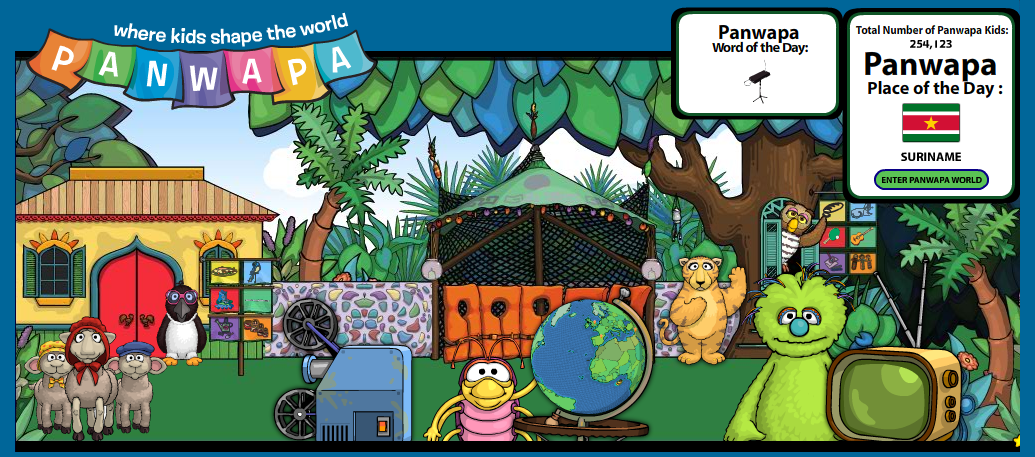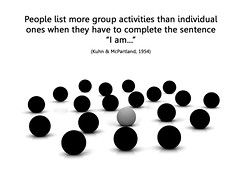We’ve been asked to critique the Sesame Workshop’s Panwapa site, a “global awareness curriculum site” for 4- to 7-year-olds, according to Sesame’s press page. 
When you first arrive on the site, one of the characters instructs you to click the globe to explore, and so I did. This led me to a place where I could create my own Panwapa kid, apparently. I did not know what this meant, but I signed up anyway. I created my own Panwapa kid and my own house, too. Both were pretty-customizable. However, even a 7-year-old would have had difficulty with all the choices, and most certainly would need guidance from an adult while doing this. (It turns out this thought would reappear throughout my short Panwapa experience.) I also was struck with the thought of how many of the customizable items — food, crafts, and clothing, for example — were rather stereotypical. And I further wondered about the value of these stereotypes in an interactive game for pre-schoolers. Do we want all 4-year-olds to think that everyone in Asia eats only rice? Perhaps I’m over-simplifying, but it is worth considering.
After creating my own Panwapa kid, I was shown the map of all other Panwapa kids. I did a bit of exploring, but that got boring really quickly and so I decided to click the “Treasure Hunt” button. This invited me to a game where I had to find other Panwapa kids who liked certain things. There were three rounds:
- Find a Panwapa kid who likes traditional American dolls.
- Find a Panwapa kid who likes sharks and ice cream.
- Find a Panwapa kid who likes sharks, ice cream, and tennis.
For each level, I had to click through many (like, more than 10) kids to see if they were a “match.” I am not sure if there was an easier way to do it, but I did so by clicking on the “Activities” and “food” buttons, and then scrolling through the kids to see what they liked. It took some time, and wasn’t all that engaging, except that I was praised by the character every time I got something correct, which was kinda nice. And at the end of it all, I got a Panwapa card for my collection. It wasn’t clear to me, however, what I could do with that card later.
I also viewed the movie game, as per Frank’s request (clicking on the little bug’s film projector). This was so confusing to me. I did not realize until the end of the film that the goal of the film was to garner appreciation for learning another language, and going to school. I thought, as I was watching, that the film was more about the marginalization of the Maasai people in Tanzania. After all, Moses says, “We are not allowed to speak our language in school” and he talks about how learning this second language was hard, but it got easier. Yet, the little bug character at the end says something to the effect of, “Did you see that? Moses learned another language to teach his community!” as if this is the coolest thing since sliced bread. What I was thinking was that obviously Moses was sent to school as a fortunate one in his village — I doubt all kids in Tanzania are going to school, especially minorities like the Maasai. And he was probably sent because he is a male, and there was probably an expectation for him to teach his community because he is probably one of only a few in the village who get to go to school.
At the end of the film, the “game” begins: watch the film again and whenever you hear Moses speak Swahili, click on the Panwapa button. What??? I gave it a shot. Apparently he does this 4 times, but I only heard / saw 3. And I am an adult who speaks 4 languages! How on earth would a 4-year-old be able to get that? If the goal of this section was to teach appreciation for other languages, I definitely think it could have been done differently. Further, I wonder if this “appreciation” lesson is age-appropriate for 4- to 7-year-olds.
It was not until after I played these games and clicked around did I find out what Sesame Workshop’s goals were for this site, and I have to say I was really surprised. Apparently Panwapa is meant to :
[help] children gain empathy for others while encouraging a broader international perspective.
You can read more detailed information about Panwapa’s educational framework here [pdf].
Frank asks, “Does it hit the mark?” My answer, as an educator: No.
It does, however, do a few things well. I identified the following problem-solving features in my brief (20 minute) exploration:
- question posing (these were peppered throughout the treasure hunt)
- identifying relationships (implicit in the treasure hunt)
- gathering information (definitely actively used in the treasure hunt)
- interpreting data (at the end of the film there is a graph provided about where other Panwapa kids go to school)
- scanning for clues (in the film game)
- ability to explore (this is huge, especially on the home page — and it should be, as almost all learning for this age group should be exploratory, in my opinion)
- identification of pattern and sequence (in the film game)
- choices – multiple answers (in the question at the end of the film game)
Other things it does well: in terms of affordances of the interactive technology — this is quite good. It was almost always clear as to what the interactive features do. E.g. if I click on the globe I will go to a map; if I hover my mouse over a character, he will speak; etc. In this sense, I did not find it difficult to navigate. However, I am not sure I could say the same for a 4- to 7-year old. In particular, I wonder about the home page, as there is so much to look at and click on. I wonder if it is too much for a wee person of that age; it could be overwhelming and end up being disjunct with no lessons learned at all.
I guess I’m not saying that Panwapa is a total failure, but no, it does not hit the mark.


